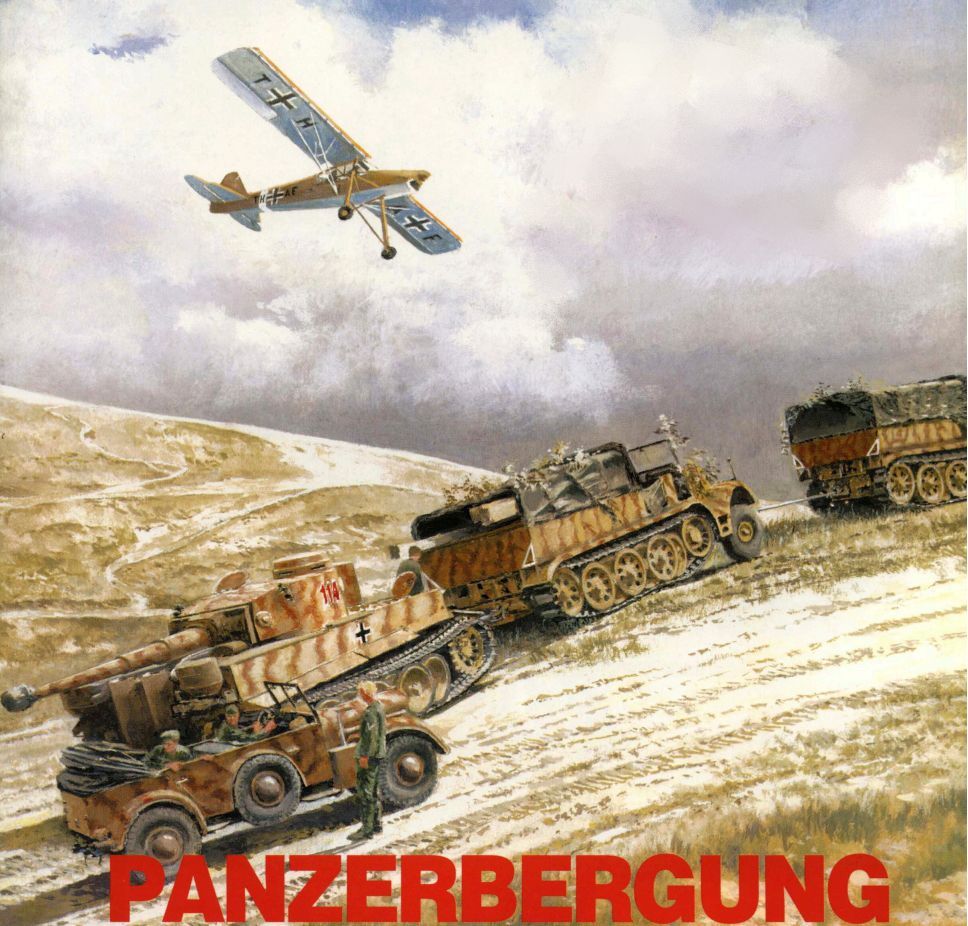
Original page 44 translation of Tigerfibel
Field Recovery Motto: With care, thought and logic – recovery is soon accomplished.
Just as you would help your comrade, no matter what, You must take care of your friend of steel too and take him home when he breaks down. If need be another Tiger can help you out, but it is better to avoid that avenue. It is better to skip any further attempts to get out on your own. You torment the engine and driveline, and it is no good anyway.
Instead: Report and let the experts talk! In the meantime, prepare for recovery, paying attention to the following:
Gustav: Frees up the tracks or opens them to check the running gear .so that resistance to towing is eliminated,
Removes the steering gear box shaft and replaces the bolts .so that the transmission is disabled, but the brakes work.
Hulsensacke and Piepmatz: Remove obstacles in front of the tracks and hull .so that the recovery effort will be lessdifficult.
Speedy Quickthinker: has checked for anchor points for the tow tractor and prepares the appropriate tools: breaker bars, tow bars, hooks, ropes and winches .in case the recovery will be done using winches.
Don’t fiddle around and waste time, or you’ll be reprimanded! Inform the commander of the recovery team on damages to the tank and avenues for recovery right away. And then everyone lends a hand! Once the vehicle is free it will be towed in a tandem train. Be alert as a watchdog when crossing bridges, fording rivers, or passing narrow roadways. Keep in contact with the towing tractors, make an extra effort giving directions, otherwise your comrades will be broadsided or the tank ends up stuck once again.
Moral: Recovery is full of difficulty, yet is a necessity.
#
Due to its size and weight the high number of breakdowns and the recovery of battle-damaged vehicles was to prove a real headache for the engineers. The tanks were immensely valuable and had to be recovered if at all possible. However, the infrastructure and, in particular the recovery vehicles, to support the easy recovery of such a heavy machine as the Tiger I was found to be severely wanting.
The main problem was that the standard German heavy Famo recovery half-track tractor could not actually tow the tank; up to three Famo tractors were usually the only way to tow just one Tiger. It was the case therefore that another Tiger was needed to tow a disabled machine, but on such occasions, the engine of the towing vehicle often overheated and sometimes resulted in an engine breakdown or fire. Tiger tanks were therefore forbidden by regulations to tow crippled comrades. In practice this order was routinely disobeyed as the alternative was the total loss of a large number of tanks that could otherwise have been saved. It was also discovered too late that the low-mounted sprocket limited the obstacle-clearing height. The wide Tiger tracks also had a bad tendency to override the sprocket, resulting in immobilisation. If a track overrode and jammed, two Tigers were normally needed to tow the tank. The jammed track was also a big problem itself, since due to high tension, it was often impossible to disassemble the track by removing the track pins. It was sometimes simply blown apart with an explosive charge.